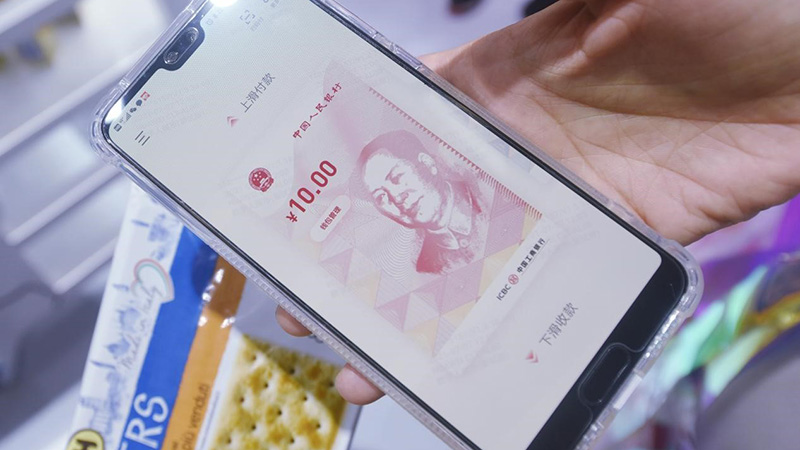How do Chinese brands gain popularity overseas?
Chinese companies have quickened their pace to go global in recent years and many of their brands have already become household names in the international market.
Transsion Holdings, a China-based smartphone manufacturer, topped the African smartphone market in terms of shipments in 2021 and captured 12.4 percent of the overall smartphone market globally, ranking it third in the global smartphone market.

A customer takes a selfie with a phone made by Transsion Holdings, a China-based smartphone manufacturer. (Photo courtesy of Transsion Holdings)
In the list of the Top 100 Most Admired Brands in Africa in 2021 published by African Business, TECNO, Itel and Infinix, the three major mobile phone brands of Transsion, ranked 6th, 21st and 25th, respectively.
Chinese down jacket brand Orolay has remained on the bestseller list on U.S. e-commerce giant Amazon for years. An article titled “The Unlikely Tale of a $140 Amazon Coat That’s Taken over the Upper East Side” in New York Magazine said that a down jacket made by Orolay is “the most popular coat of the winter, at least among a certain set of stylish uptown women.”
Founded in 2012, another Chinese apparel brand Shein has quickly become a hit among young people in countries and regions such as the U.S., Australia and Europe for its large variety of cost-effective clothing. Shein is big on social media, with 250 million followers, said the BBC. Meanwhile, the brand’s app beat Amazon to become the most popular shopping app in the U.S. in May 2021. In June last year, the brand’s website recorded 150 million visits and was the most visited in the fashion and apparel category worldwide, according to a report by brokerage firm Zhongtai Securities.
The international market provides a broader space and stage for Chinese brands, said Xie Yi, a professor at the Business School under the University of International Business and Economics.

A woman wearing a down jacket made by Chinese down jacket brand Orolay runs on a street in New York, the U.S. (Photo courtesy of Orolay)
An important reason behind Chinese brands’ success in the overseas market is that they have a deep understanding of the unique needs of consumers in different regions and adopt localization strategies in terms of marketing, products and prices, Xie explained. Chinese enterprises conduct an in-depth analysis of the economic development, cultural differences, consumer preferences, and other factors in their targeted markets, Xie added.
For instance, when Transsion Holdings was founded, the company sent personnel to both cities and rural areas in Africa to better understand what kinds of products and services local consumers needed.
Transsion released TECNO T780, its first dual-SIM phone sold on the continent, to address the then common pain point of local users having more than one SIM card. This phone went on to become a runaway success in Nigeria. Transsion then launched other feature phones with multiple SIM slots and a longer battery life, further expanding its market share in Africa.
Transsion also designed phone cameras calibrated for darker skin tones to help users take brighter and clearer photos even in low-light conditions.
Orolay has set the retail prices for its down jackets at $100 to $150, much lower than that of other down jacket brands in North America, aiming to meet female customers’ needs, according to Qiu Jiawei, founder of the company.
Qiu introduced that his company’s success is not just a tale of competitive pricing, but also good quality and a design that found favor among U.S. consumers, which is a result of the brand’s insights into the preferences of local consumers.
Xie also attributed Chinese brands’ overseas success to China’s competitive strengths in supply chains, especially in the textile industry, mobile phone manufacturing and e-commerce sector.
Orolay, for example, has its design and production based in Pinghu, a county-level city under the jurisdiction of Jiaxing city, east China’s Zhejiang Province. Pinghu is home to a wide range of upstream and downstream enterprises, including garment design companies, hardware manufacturers, and down jacket manufacturers.
“This offers us comparative strengths in lowering production costs, increasing delivery speeds and reducing inventory, thus enabling us to have a quick response to new market demands,” said Qiu.
Qiu has also ridden the wave of the flourishing cross-border e-commerce business in China and has built overseas warehouses in New Jersey in the U.S., Hamburg in Germany, and Yorkshire in the U.K., which has greatly shortened the time needed for consumers to receive and return goods while improving their shopping experience, according to Qiu.
Photos
Copyright © 2022 People's Daily Online. All Rights Reserved.










